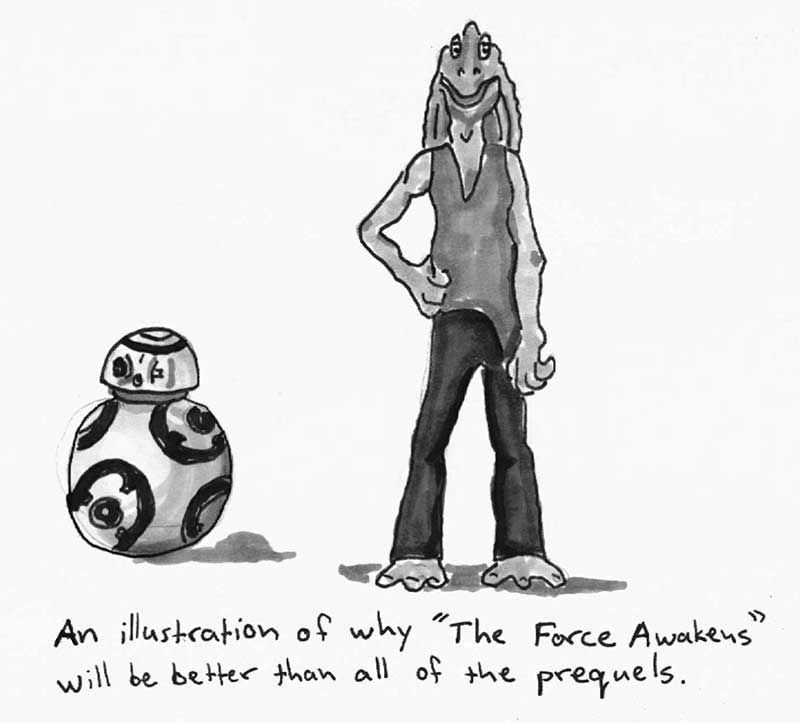This past week we were all treated to another teaser trailer for “Star Wars: The Force Awakens,” which was pretty exciting—but it still wasn’t the MOST exciting Star Wars-related viral video I saw last week. Scrolling through Facebook I noticed a friend had posted a video of the new Star Wars droid BB8. The real life, “can-roll-right-up-to-you” BB8.
My first thought was “Yes! This is it. This is what this franchise lost.” Back when the original trilogy premiered there was no CGI… or at least nothing anyone would dare try to pass off as something an audience was supposed to believe was real. But by the time the third installment of the second trilogy was released, we were so far up the CGI river that it had become surreal… and like Capt. Willard, we struggled to decipher what was real versus what was a nightmare.
In the early days of CGI I was an enthusiastic believer, mostly because of Jurassic Park, one of the first and best marriages of computer generated and practical effects. That’s how it was early on… computer generated effects were so laboriously expensive that directors only turned to them as a last resort. But by the time we hit the mid-2000’s something had flipped, and it became easier to just green screen now and fill it in later.
Now it’s so bad that viewing behind-the-scenes content on effects-driven movies makes it clear we’re smack dab in the middle of Col. Kurtz’s compound. Every actor in the movie is clad in creepy green bodysuits bristling with orange ping pong balls… the horror! I fully understand that in a world where we want movies about dragons and space monsters we’re going to need some digital firepower, but why use computers to fake up things that do exist? In the fourth Indiana Jones movie, Spielberg included one of his trademark Indy creep-out scenes (the first movie had a snake pit, the second had a tunnel full of bugs, Last Crusade had catacombs of rats). Crystal Skull had huge, flesh-eating, CGI ants. Blatantly fake and comically-oversized, they elicited no emotional response from me at all. There was a time in Spielberg’s career when the ridiculousness of such a device would have sent him scrambling back to the drawing board. In Raiders they had mechanical snakes constructed for the snake scene, but they didn’t look realistic enough, so what did he do? He had literally thousands of live snake brought in the day of the shoot. Sure, that probably required that he re-imagine several shots, because working with live animals comes with its own set of problems, but isn’t that one of the most memorable scenes in that film? Did it not stick with you? So— in the end, was it not totally worth the hassle? Honestly, I would rather have movie run times be cut by 20 minutes if directors would spend that savings on some artistic integrity.
The point is, practical effects are better. Even when they are worse they are still better. Put a kid in front of the movie Labyrinth in 2015 and he will be just as enthralled as I was when I watched it back in the 80’s. I very much doubt that any of the CGI-heavy kid-oriented-action movies of today will hold up similarly, a generation from now. Movies like The Golden Compass or Avatar: The Last Air Bender barely ring a bell, less than ten years later.
Some modern movies do get it right, to a certain degree… Peter Jackson (before his official industry-coronation with the crown of “genius” —which, by the way, is the beginning of the creative end for most movie directors) created practical effects for absolutely everything he could, and only relied on the absolute best CGI available at the time to produce the LotR movies. Yet soon after that, the overly-fake computer graphics crept into his ouvre and the next thing you know he gives us a 15-minute-scene of Apatosaurus’s tripping over each other. There was a time when effects guys, if asked “Can you make dinosaurs trip over each other for a quarter of an hour?” would have answered “No. Think of something else.” These days I suspect they would just respond with a heavy sigh and the words “Sure, whatever, man. CGI can do anything.”
The thing is: I wasn’t looking forward to the new Star Wars. I actually saw the BB8 character in the first trailer, assumed it was just another stupid CGI character and pretty much wrote it off. But NOW that I’ve discovered it’s a practical effect, I’m downright stoked. If that’s the general reaction from a majority of fans like me, why aren’t more directors turning back toward practical effects? I assume the reason is “money.” I get that. But when a movie is great I will pay to see it multiple times, and I will buy it on whatever video format is currently the best. I’ve bought the original trilogy THREE TIMES. So maybe a little more investment in real effects might pay huge dividends on the back end, since I— and countless fans like me— will watch an Endorian speeder bike battle over some computer-generated Pod race any day.


